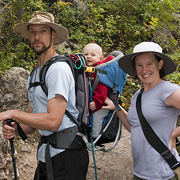Northern Colorado Tornados, Part 1: Analysis
Yes, I am a big weather geek. I spend a lot of time rock climbing and hiking, but my day job is atmospheric dynamics research. So on the morning of May 22, I was happily working away when my office mate announced that a tornado had just touched down north of Greeley, Colorado.
This was especially exciting because my husband Mark works about 20 miles south east of me, and the initial storm track had the vortex heading straight for both Mark and our house! Thankfully, for us, the storm trended more to the north, and Mark saw only high winds and hail. Throughout the day, though, storms appeared in our area and tornados touched down all around us. There is a preliminary storm report at the national weather service if you click here.
Tornados need a few things to form. They need a favorable sounding or an atmospheric profile that is conducive to deep convection. We, in the biz, measure that by the departure of the actual temperature at several heights (from a weather balloon) from the cutt-off values for a “stable” profile. The difference is called CAPE or Convective Available Potential Energy. The opposite, or places where the atmosphere is stable or more than stable is called CIN or Convective INhibition. Below, you can see that the sounding from Denver yesterday morning had a much bigger number for CAPE than CIN. Generally, however, severe weather is not expected unless CAPE tops 1000 J/kg.
So, there wasn’t as much CAPE as you would hope for a big tornado, then what happened? Well, the key here was actually the wind profile in the sounding, which I highlighted by using the colored arrows. On the left above, the wind direction at the surface is the red arrow, the next height is orange, and so on. The arrow points in the direction the wind is coming from, so you can see that in the lowest 10,000ft of the atmosphere, the winds changed direction from northeasterly to northwesterly, all the way back around to southeaserly at upper levels. That is what we call SHEER, and there was A LOT of it on this morning.
As the thunderstorms formed, the twisting winds above the surface in our area caused the updrafts to spin, acting like a kid wacking the side of a drum to spin it faster as the air rose higher. Eventually, the whole updraft was spinnging fast enough to create an extremely low pressure region inside the vortex, cloud water condensed and a funnel cloud reached down to the ground.
In this case, the funnel was almost a mile wide and destroyed a wide swath of land just to the east of my husband’s office and our house. It also traveled directly over the elementary school where my friend Liz was working, giving her and her kids a huge scare. Quite a day for exciting weather.




